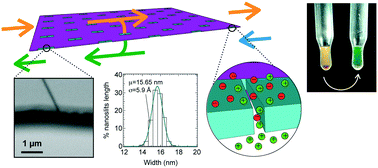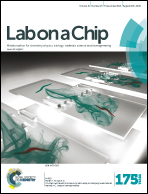Continuous high throughput nanofluidic separation through tangential-flow vertical nanoslit arrays†
Abstract
Nanofluidic devices exhibit unique, tunable transport properties that may lead to breakthroughs in molecular separations and sensing. However, the throughput of these devices is orders of magnitude too small for the processing of macroscopic samples. Here we overcome this problem by combining two technological innovations. First, nanofluidic channels are made as vertical slits connecting the two sides of a silicon nitride membrane. Arbitrary arrays of such nanoslits down to 15 nm wide with <6 Å uniformity were made by merging the idea of templating with chemical mechanical polishing to create a scalable, nanolithography-free wafer level process. Second, we provide for efficient solute transport to and from the openings of the nanoslits by incorporating the nanofluidic membrane into a microfluidic tangential-flow system, which is also fabricated at wafer level. As an exemplary application, we demonstrate charge-based continuous flow separation of small molecules with a selectivity of 100 and constant flux over more than 100 hours of operation. This proves the exciting possibility of exploiting transport phenomena governed by precision-engineered nanofluidic devices at a macroscopic scale.


 Please wait while we load your content...
Please wait while we load your content...